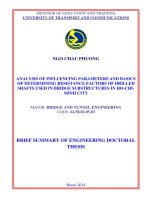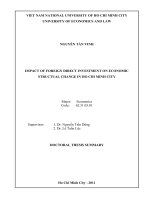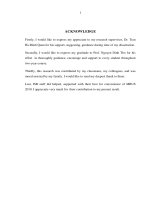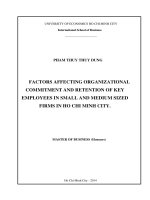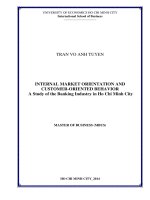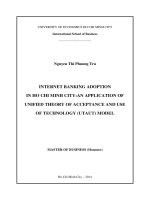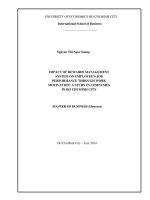Factors impact employer attractiveness among IT engineers in ho chi minh city
Bạn đang xem bản rút gọn của tài liệu. Xem và tải ngay bản đầy đủ của tài liệu tại đây (581.24 KB, 56 trang )
MINISTRY OF EDUCATION AND TRAINING
UNIVERSITY OF ECONOMICS HO CHI MINH CITY
LE TIEN THANH
FACTORS IMPACT EMPLOYER ATTRACTIVENESS
AMONG IT ENGINEERS IN HO CHI MINH CITY
MASTER OF BUSINESS ADMINISTRATION THESIS
HO CHI MINH CITY- 2011
MINISTRY OF EDUCATION AND TRAINING
UNIVERSITY OF ECONOMICS HO CHI MINH CITY
LE TIEN THANH
FACTORS IMPACT EMPLOYER ATTRACTIVENESS
AMONG IT ENGINEERS IN HO CHI MINH CITY
MAJOR: BUSINESS ADMINISTRATION
MAJOR CODE:
60.34.05
MASTER OF BUSINESS ADMINISTRATION THESIS
SUPERVISOR: DR. HO TIEN DUNG
MSc. TA THI BICH THUY
HO CHI MINH CITY- 2011
i
ACKNOWLEDGEMENT
I would like to thank my supervisors Dr. Ho Tien Dung and MSc. Ta Thi Bich Thuy
for their intensive guidance and encouragement during the course of my study.
I would like to express my sincere thanks to Dr. Pham Quoc Hung and Dr. Nguyen
Thi Nguyet Que for their reviews and constructive suggestions.
I would like to extend my sincere thanks to Professor Nguyen Dinh Tho, Dr. Tran
Ha Minh Quan, Dr. Nguyen Thi Mai Trang, members of the proposal examination
committee, for their valuable comments and feedbacks.
I would like to express my sincere gratitude to all of my teachers at Faculty of
Business Administration and Postgraduate Faculty, University of Economics Ho
Chi Minh City for their teaching and guidance during my MBA course.
Finally, I would like to specially express my thanks to my wife, my family, all of
my classmates and my friends and for their support and encouragement.
Ho Chi Minh City, 10th December 2011.
Le Tien Thanh
ii
Abstract
Master Thesis in Business Administration, Summer 2011
Economics University Ho Chi Minh City
Attracting and selecting the right types of employees, especially high quality
resources have always been a challenge for organization. But recruiting qualified
applicants may become increasingly difficult over the next 15 years as demographic
and economic factors are expected to create a “war for talent”. A recent global
survey from McKinsey in 2006 revealed that managers ranked “finding talented
people” as the single most important managerial preoccupation for the rest of the
century. Therefore, talented and skilled person will become rare and precious in the
labor market. Thus, knowing what these candidates value in an organization and
what attracts them to a company is an important prerequisite for successful
recruitment activities.
Both qualitative and quantitative approaches were considered in this research. First,
the qualitative research is conducted through making in-depth interview with eight
managers of IT/Telecommunication companies to check the content and meanings
of words using in the measurement scales. Then the main research is quantitative
with 258 engineers who currently work in IT sector. The Cronbach’s alpha is used
to measure reliability, the Exploratory Factor Analysis attempts to identify
underlying variables and regression analysis is used to test the research model and
hypotheses.
The result confirms that Interest value, Social value, Economic factors,
Development value, and Application value have positive impacts on Employer
Attractiveness among IT engineers in Ho Chi Minh City. Therefore, the benefit of
this study will help IT companies to prioritize these critical factors when they want
to enhance their attraction and attract talented IT engineers.
Key words: Employer Attractiveness, interest value, social value, development
value, economic value.
iii
Contents
Page
CHAPTER 1: INTRODUCTION ............................................................................ 1
1.1
The problem statement ........................................................................ 1
1.2
Research questions .............................................................................. 3
1.3
Research objectives ............................................................................. 3
1.4
Research methodology ........................................................................ 3
1.5
Scope and delimitations of the study ................................................... 4
1.6
Structure of the study .......................................................................... 4
CHAPTER 2: REVIEW OF RELEVANT LITERATURE ...................................... 6
2.1
Concepts ............................................................................................. 6
2.1.1
Job choice and uncertainty ........................................................ 6
2.1.2
Job choice determinants ............................................................ 7
2.1.3
Employer knowledge................................................................. 7
2.1.4
Instrumental and Symbolic attributes ........................................ 9
2.1.5
Employer Attractiveness from employee perspective .............. 10
2.2
Research Model ................................................................................ 11
2.2.1
Variables and Hypotheses ....................................................... 11
2.2.2
Research model ....................................................................... 12
CHAPTER 3: RESEARCH METHODOLOGY .................................................... 13
3.1
Research process ............................................................................... 13
3.2
The pilot research .............................................................................. 14
3.3
The main research ............................................................................. 14
3.3.1
The scales................................................................................ 15
3.3.2
The questionnaire .................................................................... 18
3.3.3
Measurement ........................................................................... 18
3.3.4
Data collection ........................................................................ 18
3.3.5
Population and sampling ......................................................... 19
CHAPTER 4: RESULTS AND DISCUSSION OF THE FINDINGS .................... 20
4.1
Descriptive statistics ......................................................................... 20
iv
4.2
Cronbach’s Alpha Analysis ............................................................... 24
4.3
EFA Analysis .................................................................................... 27
4.4
Correlation analysis........................................................................... 31
4.5
Regression analysis ........................................................................... 31
CHAPTER 5: CONCLUSIONS AND IMPLICATIONS....................................... 37
5.1
Conclusions of the research ............................................................... 37
5.2
Implications of the research............................................................... 37
5.3
Limitations and suggestion for further researches .............................. 38
REFERENCES...................................................................................................... 40
APPENDIX 1 ........................................................................................................... i
v
LIST OF TABLES & FIGURES
Table 4.1: Demographic statistics of the respondents ........................................................ 21
Table 4.2: Descriptive statistics ........................................................................................ 22
Table 4.3: Cronbach’s Alpha of all variables..................................................................... 25
Table 4.4: Cronbach’s Alpha of Employer Attractiveness after removing variable V53 ..... 26
Table 4.5: KMO and Bartlett’s Test .................................................................................. 27
Table 4.6: Total Variance Explained ................................................................................. 28
Table 4.7: Rotated Component Matrix .............................................................................. 29
Table 4.8: The final measurement scale ............................................................................ 30
Table 4.9: Mean, Standard Deviation and Correlation Coefficient ..................................... 31
Table 4.10: Regression analysis on data of 258 responses ................................................. 33
Table 4.11: Results ........................................................................................................... 36
1
CHAPTER 1: INTRODUCTION
1.1 The problem statement
Organizations have always been concerned with attracting and selecting the right
types of employees, Schneider (1987). Yet, recruiting qualified applicants may
become increasingly difficult over the next 15 years as demographic and economic
factors are expected to create a “war for talent”, Axelrod et al. (2001). Two recent
global surveys from McKinsey Quarterly strongly support this view. While the first,
in 2006, found that managers ranked “finding talented people” as the single most
important managerial preoccupation for the rest of the century, the second, in 2007,
revealed that nearly half of the respondents expect intensifying competition for
talent to have a major effect on their companies over the next five years, Guthridge,
Komm & Lawson (2008). Therefore, talented and skilled person will become rare
and precious in the labor market. Consequently, knowing what these candidates
value in an organization and what attracts them to a company is an important
prerequisite for successful recruitment activities.
Due to the above mentioned cause, it has become increasingly important for
organizations to make themselves stand out from their competitors so that they are
seen as attractive employers for prospective applicants. Undoubtedly, this is a
challenge because jobs and organizations within the same industry are often very
similar, Maurer, Howe, & Lee (1992); Taylor & Collins (2000); Thomas & Wise
(1999). According to Barber (1998), early recruitment stages are characterized by
an extensive search and screening, the gathering of rudimentary information about
multiple opportunities, and little or no personal contact between the parties
involved.
Considering the importance of applicants’ early impressions of organizations as
employers, research by Barber (1998); Cable & Graham (2000); Cable & Turban
(2001); Highhouse & Hoffman (2001); Rynes (1991); Lievens, Highhouse, (2003);
Lievens at al. (2005) were exploring the content or basis of these impressions. As in
2
Lievens, Highhouse (2003), organizational attraction was influenced by applicants'
perceptions of job and organizational characteristics such as pay, opportunities for
advancement, location, career programs, or organizational structure (Cable &
Graham, 2000; Highhouse, Zickar, Thorsteinson, Stierwalt, & Slaughter, 1999;
Honeycutt & Rosen, 1997; Lievens, Decaesteker, Coetsier, & Geirnaert, 2001;
Turban & Keon, 1993).
Besides that, in the early stages of the recruitment process, prospective applicants
ascribed traits to organizations (Slaughter, Zickar, Highhouse, Mohr, Steinbrenner,
& O'Connor, 2001). For example, people referred to some employing organizations
as trendy, whereas other employing organizations were seen as prestigious. These
studies also discovered that these trait inferences about organizations were related to
the image of organizations as employers, with applicants being more attracted to
employing organizations having traits similar to their own personality. For a better
refinement from employee perspective, Berthon, Ewing and Hah (2005) suggest
five items of Interest value, Social value, Economic value, Development value and
Application value to evaluate how an organization is attractive as an employer to
potential employees.
Vietnam is now one of the 10 most attractive global services locations in the world
(A.T Kearney, 2009) and the IT (Information Technology) industry is estimated to
grow at a compound annual growth rate of 16% over the period of 2011-2015. With
around 10,000 licensed firms to provide services, with around 2000,000 resources
(Ministry of Information and Communication, 2011).
On May 2011, German-based Bosch Group, a leading global supplier of IT services,
opened a center focusing on embedded software and mechanical engineering
services in Ho Chi Minh City. This US$4.5-million center, located at the Saigon
High-tech Park in District 9, is expected to employ around 500 local engineers by
2015.
3
This recently setup, together with the rising presence of other big IT names like HP,
Aricent, Sigma Designs, Texas Instruments, and Simax Global Services in Vietnam
lead to competition with local entrepreneurs in terms of human resources.
Although many researches in the field of employer attractiveness have been
conducted so far, few researches are available in the local context, especially for IT
industry. For this reason, it is necessary to conduct research on factors impacting
employer attractiveness among IT engineers in Ho Chi Minh City, especially with
factors such as Interest, Social, Development, Economic, Application. From this
study, companies can make suitable plans in order to enhance themselves and
become more attractive to qualified candidates.
1.2 Research questions
This paper attempts to determine “What major factors impact employer
attractiveness among IT engineers in Ho Chi Minh City?”
1.3 Research objectives
The objective of the research is to identify critical factors that affect Employer
Attractiveness among IT engineers in Ho Chi Minh City. The lessons learned from
this study would be useful for IT companies in their efforts to attract the best
candidates available in the market.
1.4 Research methodology
The purpose of this research is to identify the factors impacting employer
attractiveness among IT engineers in Ho Chi Minh City by using the EFA method,
hence both pilot research and quantitative research are considered.
The pilot research is conducted by making an in-depth interview with eight
managers of four IT companies in Ho Chi Minh City in order to get their ideas
about employer attractiveness factors and meaning of words using in the
questionnaires. The questionnaire is adapted from the literature as well as the
comments gathered from the interviews.
4
In the next step, the sample is collected by sending questionnaires to the relevant
people in the industry, who currently working in information technology
companies. An internet based form is also published in Google Docs and share via
social networking site of Facebook for additional respondent coverage. Individuals
are asked to indicate the extent of agreement or disagreement with the questionnaire
items concerning employer attractiveness on a five-point Likert-type scale ranging
from 1 (strongly disagree) to 5 (strongly agree).
After collecting data, the measurement scales will be verified by using the
Cronbach’s alpha ratio and the Exploratory Factor Analysis (EFA) is used to refine
the measurement scales. Finally, the hypotheses are tested by using regression
analysis.
1.5 Scope and delimitations of the study
This research is conducted in Ho Chi Minh City. The research subject is the IT
engineers in multiple IT companies such as IBM, HP, CSC, GCS, Harvey Nash,
TMA Solutions and other companies of the industry. The results of similar studies
in other populations may differ, and thus the results should not be over generalized.
Further, the study used a self-report measure via questionnaire and may have a selfreporting bias. Also, questionnaires do not offer the opportunity to probe deeply
into feelings or opinions, nor can items be clarified if there is any confusion as to
what an item is intended to mean.
Moreover, other factors not considered in this study may have influences on the
respondents that are more important for employer attractiveness measurements. For
example, word of mouth, corporate social responsibility (CSR) may have
substantial or significant impacts on employer attractiveness.
1.6 Structure of the study
The structure of this study includes 5 chapters. Chapter 1 presents information about
the
problem
statement,
research
question,
research
objectives,
research
5
methodology and scope of the study. Chapter 2 discusses concepts of terms and
literature review of Employer Attractiveness, after that research model is developed.
Chapter 3 explains research methodology and research model that are used in the
study. Chapter 4 analyzes the result and discussion of the findings. And finally,
conclusions and implications are presented in Chapter 5.
6
CHAPTER 2: REVIEW OF RELEVANT LITERATURE
This chapter is to focus on introducing the literature review in order to establish a
research model. There are two parts. The first section will introduce some key
concepts about Employer Attractiveness; and the second section will consider
variable, suggest the research model and the hypotheses about the impact of major
factors on Employer Attractiveness among IT engineers in Ho Chi Minh City.
2.1 Concepts
Lievens, Van Hoye, & Schreurs (2005) defined Employer Attractiveness as
organizational attractiveness as applicants’ willingness to pursue jobs and to accept
job offers in an organization.
This concept has been broadly discussed in the areas of vocational behavior (Soutar
& Clarke 1983), management (Gatewood et al. 1993), applied psychology
(Jurgensen 1978; Collins & Stevens 2002), communication (Bergstrom et al. 2002)
and marketing (Ambler & Barrow 1996; Gilly & Wolfinbarger 1998; Ambler 2000;
Ewing et al. 2002). It has also become an increasingly ‘hot topic’ in the
contemporary business press (see, for example, Sherry 2000; Lloyd 2002; Ritson
2002), and ‘Best Employer’ status is something that more and more organizations
are striving for.
2.1.1 Job choice and uncertainty
At early stages of the recruitment process it is difficult for potential applicants to
visualize exactly what it would be like to be an employee of a firm (Turban, 2001).
For starters, a workplace is more difficult to evaluate than a specific product. Not
only is it less tangible, potential applicants also face limited opportunities to
visually inspect organizations, not to mention gain firsthand working experience at
that particular workplace.
“In particular for inexperienced job seekers it is
difficult to compare available job options on the basis of the true attributes of the
job and company, as many attributes are unknown or unknowable” (Collins
7
and Stevens, 2002). Therefore as mentioned above, applicants are likely to interpret
information about the firm as providing “signals” about what it would be like to
work in the firm (Backhaus et al. 2002).
2.1.2 Job choice determinants
A variety of previous research has looked at different sets of factors important to
individuals when evaluating jobs. Thomas and Wise (1999) argue that information
directly
related
to
the
job
was
looked
importance to job seekers’ decision making than other
upon
with
organizational
greater
factors.
Lievens and Highhouse (2003) support this notion by informing that organizational
attraction is influenced by applicants’ perceptions of job and organizational
characteristics
such as pay, opportunities for advancement, location, career
programs, or organizational structure. However they argue that although potential
applicant’s initial attraction to organizations can be partially explained on the basis
of these attributes, they are probably less useful for organizations in terms of
differentiating themselves from their competitors in the early stages (Lievens and
Highhouse 2003).
2.1.3 Employer knowledge
Cable and Turban (2001) defined employer knowledge as a job seeker’s memories
and associations regarding an organization as a (potential) employer. Thus,
employer knowledge provides applicants with a template to categorize, store, and
recall employer-related information. Consistent with conceptualizations of brand
image (see Aaker, 1991; Keller, 1993), Cable and Turban (2001) differentiate
between three broad dimensions of employer knowledge: employer familiarity,
employer image, and employer reputation. These dimensions are posited to
influence applicants’ attraction to an organization as a place to work.
The first dimension is employer familiarity or the level of awareness that a job
seeker has of an organization (Cable & Turban, 2001; Collins & Stevens, 2002).
Generally, previous studies in the recruitment field have demonstrated that an
8
organization’s overall familiarity is related to applicants’ perceptions of a
company’s attractiveness as an employer, with more familiar organizations being
perceived as more attractive (Cable & Graham, 2000; Gatewood, Gowan, &
Lautenschlager, 1993; Turban, 2001).
Employer image pertains to the content of the beliefs that applicants have about the
organization as an employer (Cable & Turban, 2001; Highhouse et al., 1999).
Specifically, Cable and Turban (2001) argue that potential applicants hold beliefs
about objective aspects of the organization (employer information), varying from
factual or historical aspects of organizations to organizational procedures and
policies. Examples of employer information are size, location, level of
centralization, geographical dispersion career or organizational structure (Cable &
Graham, 2000; Highhouse et al., 1999; Lievens et al., 2001). Additionally, Cable
and Turban (2001) posit that potential applicants have some knowledge about the
attributes of a specific job at the organization to which they might consider applying
(job information). Examples of job information are pay, benefits, type of work to be
performed or advancement opportunities.
The third dimension in Cable and Turban’s (2001) framework of employer
knowledge refers to employer reputation or the public evaluation of an organization.
Although employer reputation is often cast in economic terms (Fombrun & Shanley,
1990), some recent studies provide an interesting new trait-oriented perspective to
employer reputation (Lievens & Highhouse, 2003; Slaughter, Zickar, Highhouse, &
Mohr, 2004). In particular, these studies reveal that potential applicants reliably and
meaningfully ascribe traits to organizations. For example, people refer to some
employing organizations as trendy, whereas other employing organizations are seen
as prestigious.
9
2.1.4 Instrumental and Symbolic attributes
Adding a new marketing-based angle to the study of the attractiveness of
organizations in the early stages of the recruitment process, Lievens and Highhouse
(2003) used the instrumental-symbolic framework to study employees associate
with both instrumental functions and symbolic meanings to a company. Here,
instrumental attributes are defined as describing the job or organization in terms of
objective, concrete and factual attributes that the job or organization either
possesses or not (Lievens and Highhouse 2003). Examples of instrumental attributes
are pay, location, opportunities for advancement, career programs. Much traditional
recruitment research has found empirical support for the importance of instrumental
job and organizational characteristics as determinants of applicants’ attraction to the
firms: organizational characteristics (e.g., Cable and Graham, 2000; Turban, 2001;
Turban and Greening, 1997; Turban and Keon, 1993), and job characteristics (e.g.,
Barber and Roehling, 1993; Bretz and Judge, 1994; Turban et al., 1993).
Symbolic attributes are linked to people’s need to maintain their self-identity,
enhance their self-image, or express themselves. According to Backhaus and Tikoo
(2004), in the context of recruitment, symbolic benefits are related to how potential
applicants will be attracted to a firm based on the extent to which they believe that
the firm possesses the desired employee related attributes and the relative
importance they place on those attributes.
By drawing on this instrumental-symbolic framework, Lievens and Lighthouse,
(2003) found that the symbolic meaning prospective employees associate with the
employing
organizations
was given
a
more important role
in
applicant’s
attractiveness to an organization than job and organizational attributes. Although
their study was limited to companies within the same industry, their findings
suggest that applicants overall are more attracted to employing organizations which
traits are similar to their own personality and values. This corresponds with the
context of social identity theory, in which scholars such as Ashforth and Mael,
10
(1989) and Dutton et al. (1994) believe that the organization in which people work
is one of the most important determinants of their self-concept as well as social
identity. As such the individual’s identification with the organization requires an
idea of an organization with some distinct features the individual can identify with.
Moreover, Lievens and Highhouse (2003) discover that trait inferences (e.g.
innovativeness) about Belgian banks account for incremental variance over and
above job and organizational attributes in predicting a bank’s perceived
attractiveness as an employer.
2.1.5 Employer Attractiveness from employee perspective
Refining Cable and Turban’s concept of Employer Knowledge (2001) and Lievens
and Highhouse’s instrumental and symbolic framework (2003), Berthon, Ewing,
Hah (2005) suggest a way to both identify and operationalize the components of
employer attractiveness from the perspective of potential employees. The five
factors are: Interest value, Social value, Economic value, Development value, and
Application value.
Interest value assesses the extent to which an individual is attracted to an employer
that provides an exciting work environment, novel work practices and that makes
use of its employee’s creativity to produce high quality, innovative products and
services.
Social value assesses the extent to which an individual is attracted to an employer
that provides a working environment that is fun, happy, provides good collegial
relationships and a team atmosphere. Thus this value represents an organization’s
working environment.
Economic value assesses the extent to which an individual is attracted to an
employer that provides above-average salary, compensation package, job security
and promotional opportunities.
11
Development value assesses the extent to which an individual is attracted to an
employer that provides recognition, self-worth and confidence, coupled with a
career-enhancing experience and a springboard to future employment.
Finally Application value assesses the extent to which an individual is attracted to
an employer that provides an opportunity for the employee to apply what they have
learned and to teach others, in an environment that is both customer orientated and
humanitarian.
2.2 Research Model
This study empirically examines the factors impacting Employer Attractiveness
among IT engineers in Ho Chi Minh City from the perspective of potential
employees.
2.2.1 Variables and Hypotheses
2.2.1.1 The dependent variable
In this research, the dependent variable is Employer Attractiveness. In the literature
review, the concept is defined as applicants’ willingness to pursue jobs and to
accept job offers in an organization, Lievens, Van Hoye, & Schreurs (2005).
2.2.1.2 Independent variables and hypotheses
Independent variables represent the treatments or conditions that the researcher has
either direct or indirect control over to test their effects on a particular outcome. In
this research, the dependent variables include factors as mentioned in the literature
review which are Interest, Social, Development, Economic and Application.
From the definition of the factors of Employer Attractiveness and related research,
the author accepts a total of 25 indicators (Dimensions/ Observed variables)
component to measure. And following hypotheses are formulated to test the affect
to Employer Attractiveness:
12
H1: Interest value has a positive impact on Employer Attractiveness among IT
engineers in Ho Chi Minh City.
H2: Social value has a positive impact on Employer Attractiveness among IT
engineers in Ho Chi Minh City.
H3: Economic value has a positive impact on Employer Attractiveness among IT
engineers in Ho Chi Minh City.
H4: Development value has a positive impact on Employer Attractiveness among
IT engineers in Ho Chi Minh City.
H5: Application value has a positive impact on Employer Attractiveness among IT
engineers in Ho Chi Minh City.
2.2.2 Research model
In order to evaluate factors impact on Employer Attractiveness among IT engineers
in Ho Chi Minh City, this study proposes a research model would be presented as
bellow:
Interest
H1
11
Social
H2
H3
Employer
Attractiveness
Economic
H4
Development
H5
Application
13
CHAPTER 3: RESEARCH METHODOLOGY
This chapter highlights how the research problem was explored, with specific
reference made to how the participants were selected and the procedure followed to
gather the data.
Furthermore, the measuring instruments to gather the data and its ensuing
psychometric properties are discussed. The chapter concludes with the statistical
techniques utilized for the data analysis.
3.1 Research process
LITERATURE REVIEW
THE PILOT SURVEY USING THE
INITIAL MEASUREMENT SCALES
(Qualitative research: n =8)
THE MAIN RESEARCH USING THE
MAIN MEASUREMENT SCALES
(Quantitative: n=258)
WRITING REPORT
Figure 3.1: The research process
The initial 25
measurement
variables
The main 24
measurement
variables
Reliability
analysis,
Exploratory
Factor
Analysis, linear
regression
analysis
14
3.2 The pilot research
The pilot research is undertaken with in-depth interviews with questions adapted
from literature. The interviewees are selected with intention to cover a range of
possible viewpoints, whose are project managers with the aim of modifying and
refining the scale items.
The procedure for qualitative research is: (1) Personal contacts were made firstly
through telephone calls and e-mails. (2) After having the acceptance from them, the
interview will be conducted in an open-ended questions, thus the interviewees can
answer as they will. (3) After the interview, e-mails and informal meeting were used
for solving unclear information which was collected during the interview.
Based on adaption from the literature and the field visits, in the Vietnamese
context, interviewees all agree that Interest, Social, Economic, Development and
Application are factors that impact Employer Attractiveness.
The pilot survey results would help to create the main questionnaire that would be
used in the main research. From the result, the experts are all understood the content
and the meaning of each statement of the measurement scales. But in the Social
construct, there’s no difference between a fun working environments versus a happy
working environment from local culture perspective. Therefore, the initial
measurement scales were reduced to 24 measurements in the main research.
3.3 The main research
The main research is conducted by quantitative method with 258 IT engineers in Ho
Chi Minh City through email and via link shared on social network.
The collected data from the main research was analyzed by using SPSS 19.0
software on Windows (Descriptive Statistics, Reliability analysis, Correlation
analysis, Exploratory Factor Analysis (EFA), the multi-linear regression analysis).
The reason was to verify the measurement model, research model and test the
hypotheses
15
3.3.1 The scales
The measuring scales use the five-point Likert scales with the anchors from strongly
disagree (1) to strongly agree (5). The items evaluated the following attributes:
Interest (5 items), Social (4 items), Economic (5 items), Development (5 items),
Application (3 items) and Employer Attractiveness (4 items). Those items are
adapted from the literature review and listed in the following table:
16
Table 3.1: The Measuring Scales
Dimension
Interest
Coded
V11
Description
I believe the company X produces innovative products
and services
V12
I believe company X is an innovative employer –
novel work practices/forward thinking
V13
The company X both values and makes use of my
creativity
V14
I believe company X produces high quality products
and services
V15
I believe company X would be an exciting working
environment to work for
Social
V21
I believe company X would be a place where I would
have a good relationship with my colleagues
V22
I believe company X would be a place where I would
have a good relationship with my superiors
V23
I believe my colleagues at company X would be
supportive and encouraging.
Economic
V24
I believe it would be a fun company to work in
V31
I would believe company X have good promotion
opportunities
V32
I would believe company X provide job security
V33
I believe company X would offer an above average
basic salary
V34
I believe company X would offer an attractive overall
compensation package
17
V35
I believe company X would provide me hands on
inter-department experience
Development
V41
I believe company X would be a springboard for future
employment
V42
I believe I would feel good about myself as a result of
working for this company
V43
I believe I would feel more self-confident as a result of
working for this company
V44
I believe I would gain career-enhancing experience
V45
I believe company X has a management that
recognizes and appreciates their employees
Application
V51
I believe company X would provide me the
opportunity to teach others what I have learned
V52
I believe I would have the opportunity to apply what I
was learned from institution at company X
V53
I believe company X is customer-orientated
V54
I believe company X is a humanitarian organization –
gives back to society
V55
I believe I would feel accepted as well as a sense of
belongingness at company X
Overall
R1
For me, company X would be a good place to work
Employer
R2
Company X is attractive to me as a place for
Attractiveness
employment
R3
I’m interested in learning more about company X
R4
A job at company X is very appealing to me.
18
3.3.2 The questionnaire
The questionnaire is divided into two major parts: the first part identifies the
respondents’ perception of the factors. The second part collects data regarding the
overall employer attractiveness. The questionnaire in Vietnamese was presented in
Appendix 1.
3.3.3 Measurement
With respect to the type of scales used to measure the items in the study, the fivepoint Likert scales, anchored by (1) strongly disagree and (5) strongly agree, are
used to measure hypotheses. This approach would simplify data entry and
interpretation, as higher scores mean higher ratings. Respondents would be required
to choose the number on the five-point Likert scales to indicate their opinion on
each statement.
3.3.4 Data collection
The questionnaires, originally in English are translated into Vietnamese to conduct
the survey. To ensure the consistency of the questionnaire between English version
and Vietnamese version, three experts was asked to back-translate the Vietnamese
version questionnaire to English version. By comparing the back-translated English
version with the original English version questionnaire, most items share the same
meaning. For those discrepant items, further refinement was conducted and second
round back-translation was conducted to make the final Vietnamese version
questionnaires consistent with the original English version.
The target of this study was IT engineers whose work mainly performed via
computer and internet. The author uses the key informant method for collecting
information by posting a survey on Google docs then email and send request via
social network of Facebook to relevant respondents. About three hundred and fifty
survey questionnaires are sent to IT engineers in Ho Chi Minh City. In total, two
hundred fifty eight questionnaires are acceptable.

